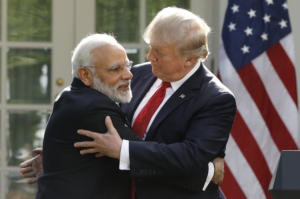
Donald Trump is well known for establishing “alpha-male dominance” over visiting heads of state and dignitaries with a buffoonish handshake in which he seizes the extended hand, grabbing it and pulling hard in a move almost like a parody of a martial arts maneuver. Not so on June 26, when he met with Indian Prime Minister Narendra Modi. At the conclusion of their talk, Modi evaded the handshake by grabbing Trump in an awkward bear hug, putting a clear seal of approval on their meeting for all to see.
Not surprisingly, the news spread of how the two hit it off immediately like good friends just beginning to form a mutual appreciation society. Their affinity is easy to understand. Both rose to power in divisive campaigns fueled by rage and transparent appeals to bigotry. Who can forget Trump’s demonization of the “other,” in so many forms: Mexicans, Muslims, immigrants, the disabled community, racial minorities. Modi, a charismatic leader to his followers, inflamed public opinion against Muslims, molding his right wing Hindu Bharatiya Janata Party (BJP) into a dominant force in Indian politics.
As we’ve seen in this country, it should be no surprise that inflammatory rhetoric by demagogic politicians can lead to actual violence. When Modi was chief minister in Gujarat, more than 1,000 people, most of them Muslims, were killed in 2002 after 60 Hindus died in a train fire. A Human Rights Watch report that year found that the state government and local police forces were implicated in the wave of violence. Modi later said that his only regret was that he could have better handled his response to the media. As a result of the wave of anti-Muslim killing, widely described as a pogrom, the U.S. government banned Modi from the country between 2005 and 2014. The ban was lifted when he was elected Prime Minister.
Although both politicians clearly have a personal affinity, the two countries differ on some important policy issues. U.S. companies have accused India of having trade barriers that unfairly protect local industries. Trump also had previously said India received massive foreign aid for signing the Paris climate accord.
Another potential disagreement could be a contentious negotiation about H1-B visas, which have been created to allow highly skilled workers trained in fields such as science, technology, and technology, to work on a temporary basis for U.S. companies. In April, Trump signed an executive order designated “Buy and Hire American,” signaling an intent to reduce the numbers of workers who will be given these visas.
India buys $2 billion worth of drones
For the most part, Trump and Modi avoided talk about those policy details, focusing on the “positive” relations between both countries. Paying respect to the the military industrial complex, Trump thanked Modi for India’s purchase of military equipment: “Nobody makes military equipment like we make military equipment, so thank you very much.” Shortly before the meeting took place, the Trump administration approved sale of 22 unarmed drones, worth about $2 billion, to India. Over the last 10 years, India has bought more than $15 billion in weaponry and military equipment from the U.S.
In both countries, appeals to bigotry divert attention while masses of people live in extreme poverty far from the spotlight. For the last few years, the U.S. corporate mass media have marveled at India’s large middle class of consumers, and also the huge, poorly paid labor force easily exploited by multi-national corporations. This focus ignores the fact that hundreds of millions of Indians live in stark poverty. A World Bank report showed 270 million Indians, roughly 30 percent of the population, living in poverty, defined as living on less than $1.90 a day. India in fact has the largest number of people living in poverty.
In India and the U.S. indigenous communities have faced violence because they live on land that major corporations want. Standing Rock is just one particularly well known example. Novelist and activist Arundhati Roy is one of many people who have spoken against the violence against poor communities in India. The state of Chhattisgarh, with large reserves of minerals, including coal, tin, bauxite, iron ore, and gold, has been described as a war zone, with local communities fighting against major corporations and the interests of powerful elites.
These real conflicts are not part of the news story as Trump and Modi smile for the cameras, brag about their 30 million-plus Twitter followers, and look forward to a future that will include Ivanka Trump’s visit to a Global Entrepeneurship Summit in India later this year.





